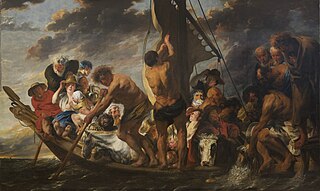The Temple tax (מחצית השקל, lit. 'half shekel') was a tax paid by Israelites and Levites which went towards the upkeep of the Jewish Temple, as reported in the New Testament. Traditionally, Kohanim (Jewish priests) were exempt from the tax.
Hebrew Bible
In later centuries, the half-shekel was adopted as the amount of the Temple tax, although in Nehemiah 10:32–34 the tax is given as a third of a shekel.
This is what each one who is registered shall give: half a shekel according to the shekel of the sanctuary (the shekel is twenty gerahs), half a shekel as an offering to the Lord.
— Exodus 30:13 NRSV
A Tyrian shekel contained 13.1g of pure silver; at a spot valuation of US$28/ozt in 2021, worth about $12.
After the return under Nehemiah, Jews in the Diaspora continued to pay the Temple tax. Josephus reported that at the end of the 30s CE "many tens of thousands" of Babylonian Jews guarded the convoy taking the tax to Jerusalem (Ant. 18.313).
New Testament
The tax is mentioned in the Gospel of Matthew in the New Testament, when Jesus and his disciples were in Capernaum. The collectors of the temple tax (Greek: δίδραχμα, didrachma) came to Peter and said "Does your teacher not pay the temple tax?" The narrative, which does not appear in the other gospels, leads to a discussion between Jesus and Peter about payment of the taxes levied by the "kings of the earth", and the miracle according to which Peter finds a stater (Greek: στατήρα), in the mouth of a fish, which is used to pay the tax due for both of them. The stater "was reckoned as equal to four drachmæ, and would therefore pay the didrachma both for Peter and his Master".
Although the word "temple" does not appear in this text, the KJV translates it to "Tribute", but it is certainly "the Tax inaugurated by God in the wilderness" in Exodus 30:11–16. In the NET translation the same Greek word (Greek: δίδραχμα, didrachma) is translated first as "Temple Tax" and second as "Double-Drachma" to strongly infer its meaning.

After the destruction of the Temple
| This section includes a list of references, related reading, or external links, but its sources remain unclear because it lacks inline citations. Please help improve this section by introducing more precise citations. (December 2019) (Learn how and when to remove this message) |
The first Roman attempt to halt payments of the tax was made long before The Jewish War on account of customs controls. The Senate had forbidden the export of gold and silver, but the Jews of Italy continued to pay the Temple tax. In 62 BCE L. Valerius Flaccus, governor of the province of Asia, issued an edict forbidding the Jews of his province from sending the tax to Jerusalem. After the destruction of the Temple in Jerusalem in 70 AD, a new Roman tax was imposed on the Jews, the Fiscus Judaicus, which was diverted into imperial coffers.
References
- Matthew 11–28; William Barclay (2001), The Temple Tax, p. 196; Matthew 17:24–27: "When they came to Capernaum, those who received the half-shekel Temple tax ... the basis of Exodus 30:13, it was laid down that every male Jew over twenty years of age must pay an annual Temple tax of ..."
- Aaron Levine 2011 The Oxford Handbook of Judaism and Economics, page 570: "... with the twenty-gerah shekel that is mentioned in the Torah (e.g., Exodus 30:13). ... In later centuries the half-shekel was adopted as the amount of the Temple Tax (although, in Nehemiah 10:32–34, the tax is given as a third of a shekel) ..."
- Jostein Ådna, 2005 The Formation of the Early Church, page 21: "... by specially appointed envoys from communities all over the Diaspora. For example, Josephus reports that at the end of the 30s CE "many tens of thousands" (Ant. 18.313) of Jews in Babylon shared in the convoy of the Temple tax in fear of ..."
- Matthew 17:24
- Matthew 17:25–27
- Charles Ellicott, Commentary for Modern Readers on Matthew 17, accessed 30 January 2017
- Martin G. Collins "The Miracles of Jesus Christ: The Coin in the Fish's Mouth", Bible tools.
- Exodus 30:11–16
- Matthew 17:24
